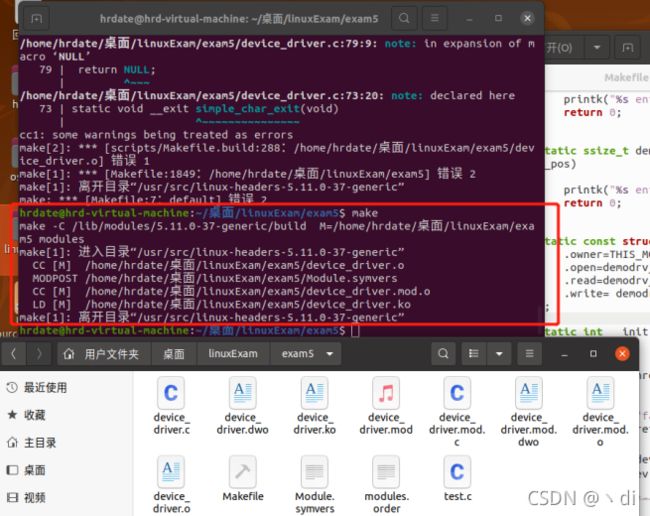设备驱动: Linux系统下的字符设备驱动程序编程
一、实验目的
通过一个简单的设备驱动的实现过程。学会Linux中设备驱动程序的编写。
二、实验环境
Ubuntu20.04TSL,Linux5.10.0
三、实验内容
1、编写一个字符设备驱动程序,并在设备的打开操作中打印主次设备号;
2、编写一个用户测试程序,实现设备的读操作。
四、实验原理 实验中用到的系统调用函数(包括实验原理中介绍的和自己采用的),实验步骤
字符设备是指只能一个字节一个字节读写的设备,不能随机读取设备内存中的某一数据,读取数据需要按照先后顺序。字符设备是面向流的设备,常见的字符设备有鼠标、键盘、串口、控制台和LED设备等。每一个字符设备都在/dev目录下对应一个设备文件。linux用户程序通过设备文件(或称设备节点)来使用驱动程序操作字符设备。一个字符设备都有一个主设备号和一个次设备号。主设备号用来标识与设备文件相连的驱动程序,用来反映设备类型。次设备号被驱动程序用来辨别操作的是哪个设备,用来区分同类型的设备。
描述字符设备的数据结构
在Linux 2.6内核中的字符设备用cdev结构来描述,其定义如下:
struct cdev
{
struct kobject kobj; //类似对象类,驱动模块的基础对象
struct module *owner; //所属内核模块,一般为THIS_MODULE
const struct file_operations *ops; //文件操作结构
struct list_head list;
dev_t dev; //设备号,int 类型,高12位为主设备号,低20位为次设备号
unsigned int count;
};
2、字符设备驱动模块的编写
实现一个基本的字符驱动设备需要以下几个部分:字符设备驱动模块的加载、卸载函数和file_operations结构中的成员函数。具体步骤如下:
(1)分配和释放设备号
在设备驱动程序中,注册设备前首先要向系统申请设备号,
分配设备号有静态和动态的两种方法:
静态分配(register_chrdev_region()函数)
动态分配(alloc_chrdev_region())
通过 unregister_chrdev_region()函数释放已分配的(无论是静态的还是动态的)设备号。
(2)定义并初始化一个struct file_operations结构,并实现其中的操作函数
static struct file_operations cdrv_fops = {
.owner=THIS_MODULE, /* 这是一个宏,推向编译模块时自动创建的__this_module变量 */
.open=cdrv_open,
.read=cdrv_read,
.write=cdrv_write,
};
static int cdrv_open(struct inode *inode, struct file *filp)
static ssize_t cdrv_read(struct file *filp, char __user *buf, size_t size, loff_t *ppos)
static ssize_t cdrv_write(struct file *filp, const char __user *buf, size_t size, loff_t *ppos)
(3)字符设备的注册
(4)删除字符设备
(5)注销设备号
(6)模块声明 MODULE_LICENSE(“GPL”);
(7)加载模块 module_init(cdrv_init);
(8)卸载模块module_exit(cdrv_exit);
3、编译模块Makefile文件
4、利用mknod命令在/dev目录下为字符设备生成对应的节点
五、实验结果分析(截屏的实验结果,与实验结果对应的实验分析)
字符设备驱动模块 device_driver.c
用户测试程序test.c
编写Makefile文件

编译字符驱动内核模块
…………# make
执行发现编译错误,对函数被拼写错误,分号的中英文格式等问题进行修改

根据提示成功修改后,再次执行make指令,则会产生一些系列模块文件
…………# sudo insmod device_driver.ko
采用高级管理员权限插入模块到内核
查看系统信息
…………#dmesg
采用|管道配合grep过滤不需要的文件,筛选出刚出入的devic_driver模块的进程号为16384

插入的设备需要在/dev目录下生成对应的结点
…………# mknod /dev/demo_drv c 主设备号 0

使用cat /proc/devices指令,查看当前系统设备上已经存在的设备号,查看到动态申请237号作为本次实验的主设备号
执行指令:sudo mknod /dev/demo_drv c 237 0

查看/dev目录情况
…………# ls /dev
在目录/dev下黄色标明文件名的文件,都是当前系统的设备;在这里也可以查看到刚刚插入的demo_drv字符设备

编译用户测试程序
………# gcc test.c -o test
………#./test

………# dmesg
使用dmesg | tail查看最近的日记信息

Makefile
ifneq ($(KERNELRELEASE),)
obj-m+=device_driver.o
else
KERNELDIR:=/lib/modules/$(shell uname -r)/build
PWD:=$(shell pwd)
default:
$(MAKE) -C $(KERNELDIR) M=$(PWD) modules
clean:
rm -rf *.o *.mod.c *.ko *.order *.symvers .*.cmd .tmp_versions
endif
Test.c
#includeDevice_driver.c
#include